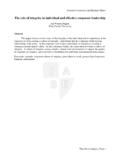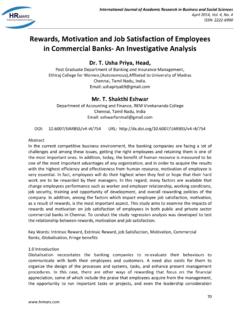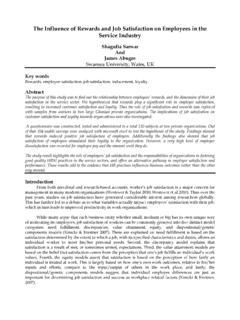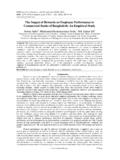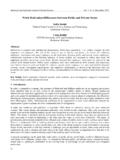Transcription of Five key ingredients for improving student motivation
1 Research in Higher Education Journal Five key ingredients for improving student motivation Kaylene C. Williams California State University, Stanislaus Caroline C. Williams University of Wisconsin, Madison ABSTRACT. motivation is probably the most important factor that educators can target in order to improve learning. Numerous cross-disciplinary theories have been postulated to explain motivation . While each of these theories has some truth, no single theory seems to adequately explain all human motivation . The fact is that human beings in general and students in particular are complex creatures with complex needs and desires.
2 With regard to students , very little if any learning can occur unless students are motivated on a consistent basis. The five key ingredients impacting student motivation are: student , teacher, content, method/process, and environment. The focus of this article is to provide the educator with suggestions from each of the five key ingredient areas that can be used to motivate his or her students . What is the best way to motivate students ? The short answer is that all of the strategies enumerated in this paper can be used as often as possible. Educators could start just by choosing and trying three new possibilities for enriching student motivation .
3 Or, more importantly, educators could watch themselves and their own behaviors to become self-aware of new understandings about motivation . Keywords: student motivation , learning success, improving educational motivation , student success Five key ingredients , Page 1. Research in Higher Education Journal INTRODUCTION. The educational equivalent to location, location, location is likely to be motivation , motivation , motivation , for motivation is probably the most important factor that educators can target in order to improve learning (Olson, 1997). motivation is defined as the act or process of motivating; the condition of being motivating; a motivating force, stimulus, or influence.
4 Incentive; drive; something (such as a need or desire) that causes a person or student to act (Merriam-Webster, 1997); and the expenditure of effort to accomplish results (DuBrin, 2008). Numerous cross-disciplinary theories have been postulated to explain motivation . For example, some theories claim that people or students are motivated by material rewards, desire to increase their power and prestige in the world, interesting work, enriched environments, recognition, or being respected as an individual. Each of these theories has some truth but no single theory seems to adequately explain all human motivation .
5 The fact is human beings in general and students in particular are complex creatures with complex needs and desires. students are not purely physical, economic, political, or psychological beings. Beecher said, God made man to go by motives, and he will not go without them anymore than a boat without steam, or a balloon without gas. Find out what motivates man, touch that button to turn the key that makes men achieve. (Helmlinger, 1997). student motivation is an essential element that is necessary for quality education. How do we know when students are motivated? They pay attention, they begin working on tasks immediately, they ask questions and volunteer answers, and they appear to be happy and eager (Palmer, 2007).
6 Basically, very little if any learning can occur unless students are motivated on a consistent basis. The five key ingredients impacting student motivation are: student , teacher, content, method/process, and environment. For example, the student must have access, ability, interest, and value education. The teacher must be well trained, must focus and monitor the educational process, be dedicated and responsive to his or her students , and be inspirational. The content must be accurate, timely, stimulating, and pertinent to the student 's current and future needs. The method or process must be inventive, encouraging, interesting, beneficial, and provide tools that can be applied to the student 's real life.
7 The environment needs to be accessible, safe, positive, personalized as much as possible, and empowering. motivation is optimized when students are exposed to a large number of these motivating experiences and variables on a regular basis. That is, students ideally should have many sources of motivation in their learning experience in each class. (Palmer, 2007; Debnath, 2005; D'Souza and Maheshwari, 2010). The focus of this article is to provide the educator with suggestions that can be used to motivate his or her students . As such, suggestions are provided for each of the five key ingredient areas impacting student motivation : student , teacher, content, method/process, and environment.
8 Please see Table 1 (Appendix) for a synopsis of these five key ingredients . INGREDIENT 1: student . You cannot push anyone up the ladder unless he is willing to climb himself. - Robert Schuller The student 's role in education is crucial and should go beyond the traditional view of student as customer or recipient of knowledge. In addition to the roles of buyer and recipient, Five key ingredients , Page 2. Research in Higher Education Journal students are the raw materials for education and the primary products of educational transformations; and most are key members of the labor force involved in creating education (Lengnick-Hall and Sanders, 1997, p.)
9 1335). Also, the increasing diversity of individual differences among students can be seen in time management, learning styles, maturity, demographics, experiential background, cultural orientation, and interests. As such, Senge et al. (1994, p. 489) suggest that teachers should be producers of environments that allow students to learn as much as possible or that schools should become learning habitats wherein relationships are fostered between people, students develop their own individual instruction plan, and a variety of investigating system options replace the passive receipt of information. (Senge et al.
10 , 1994; Lengnick-Hall and Sanders, 1997) Some tips for improving Ingredient 1 or student contributions to motivation as listed below. That is, student motivation is enhanced when these factors pertinent to students are present: Intrinsic and extrinsic motivation : Typical students bring varying degrees of both intrinsic and extrinsic motivation to the learning arena. Intrinsic motivational factors found to be at work with most students include involvement (the desire to be involved), curiosity (find out more about their interests), challenge (figuring out the complexity of a topic), and social interaction (creating social bonds).









